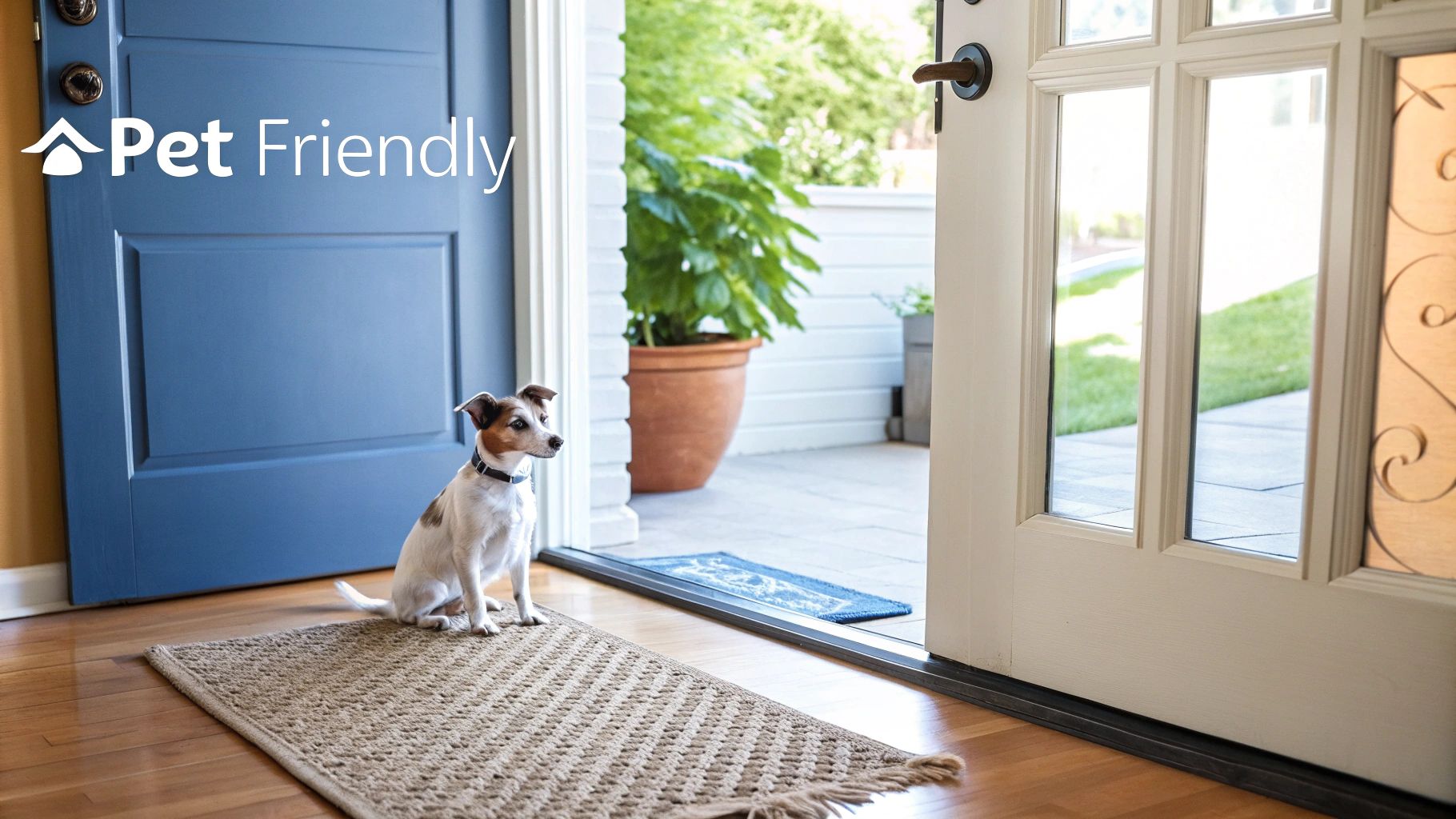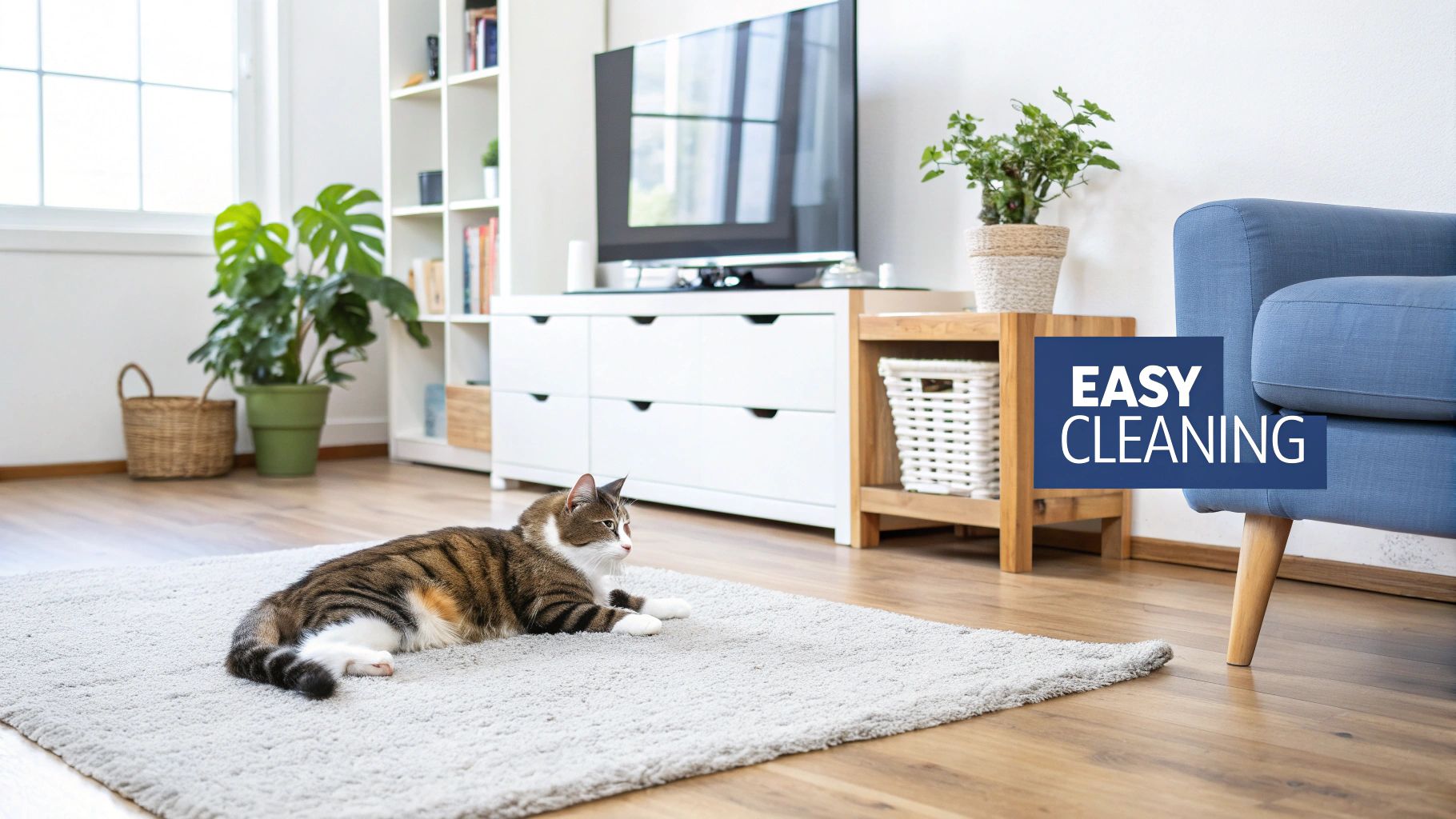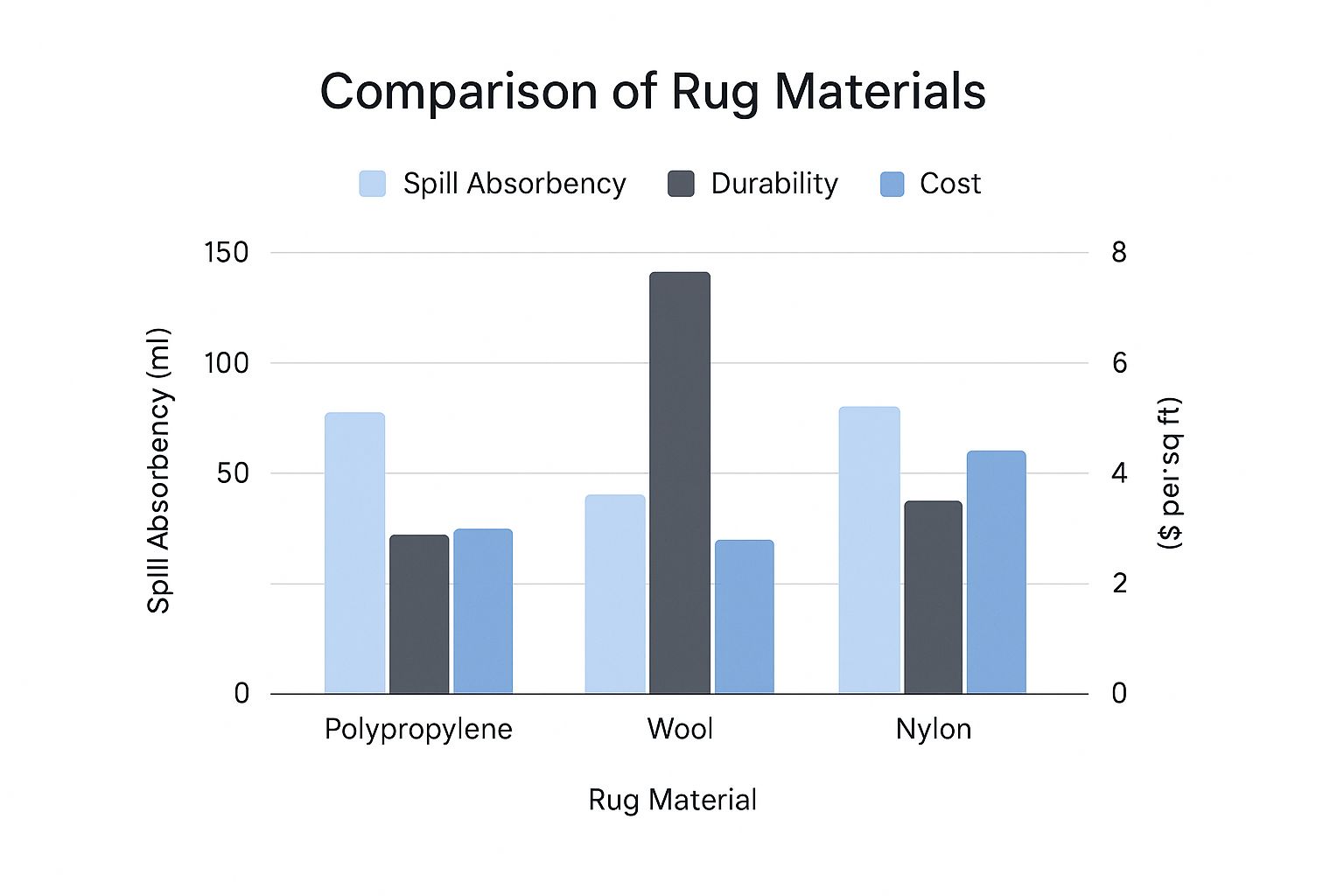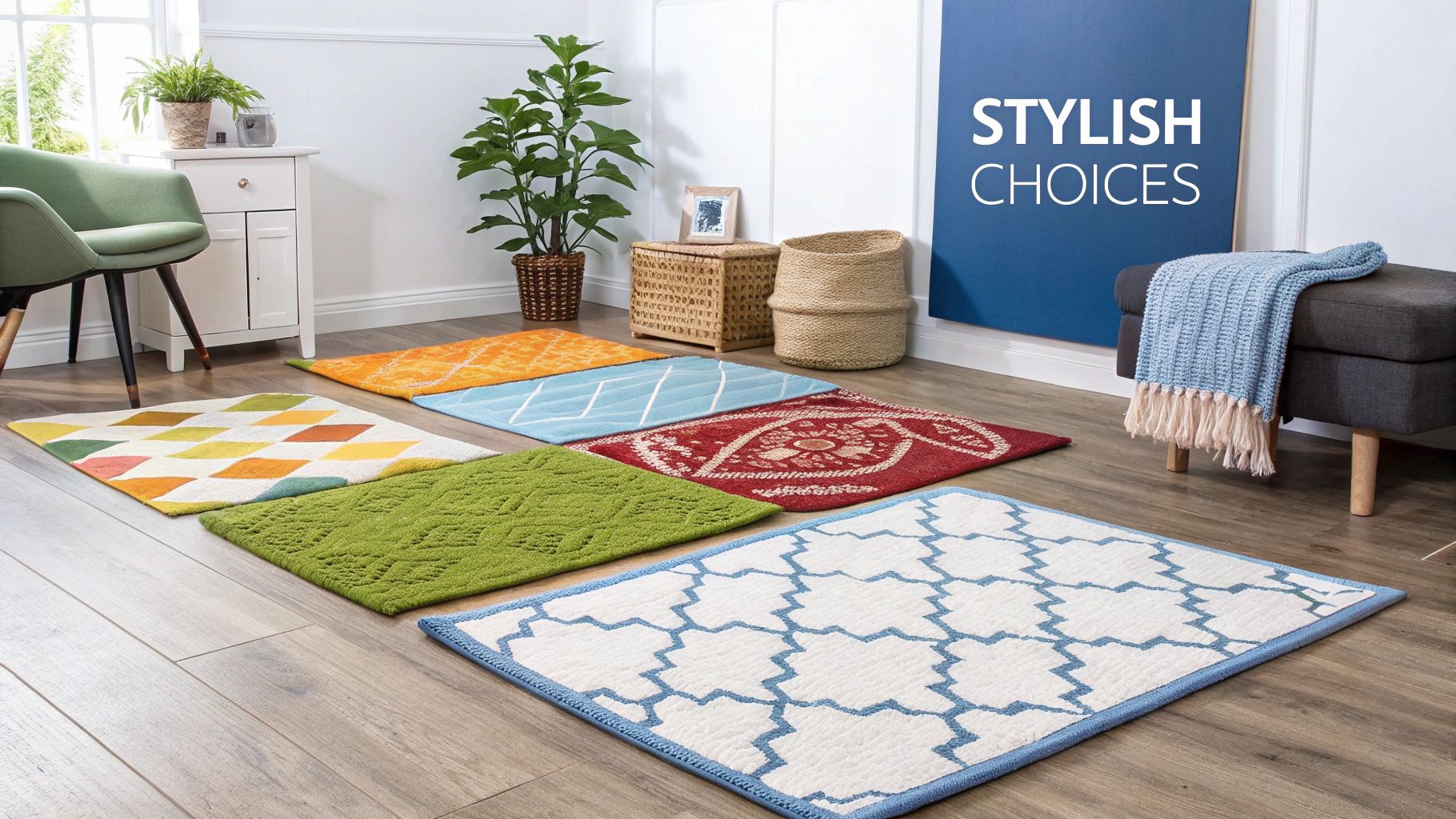Finding a great pet-friendly rug is all about striking that perfect balance between durability and style. You need something that can stand up to muddy paws and constant shedding but still looks fantastic in your home. The best choices are almost always low-pile rugs made from tough synthetic materials like polypropylene or nylon—they’re known for being stain-resistant and a breeze to clean.
Why a Pet-Friendly Rug Is a Home Essential

When you share your home with pets, you learn to embrace a bit of beautiful chaos. Whether it’s muddy paw prints after a rainy-day walk or the never-ending battle with fur, our beloved animals bring their own set of challenges to home styling. For a long time, it felt like pet owners had to make a tough choice: give up on nice floors for the sake of their furry friends, or settle for cold, bare rooms.
Thankfully, you no longer have to compromise. The right pet-friendly rug acts as the perfect middle ground, protecting your floors while adding warmth and style to your space. Think of it as your home's first line of defence against the daily wear and tear that comes with having a four-legged family member.
The Modern Pet Owner's Dilemma
Here in Australia, this is a familiar story. With nearly 40% of households owning dogs and just under 30% owning cats, the need for hard-wearing, stylish home furnishings has never been greater. This has even had a knock-on effect on the Australian carpet cleaner market, which is expected to grow to USD 21.50 million, largely thanks to pet owners looking for solutions to combat stains and odours. You can dive into more data on this market trend and what's driving it.
A purpose-built rug is designed to tackle the big three pet-related problems head-on:
- Stains and Odours: Accidents are inevitable, but a good rug won't hold a grudge (or a smell).
- Shedding and Dander: The right texture makes vacuuming up pet hair feel less like a chore and more like a quick tidy-up.
- Scratches and Snags: A durable, low-pile weave means claws are less likely to catch and pull, keeping your rug looking its best.
A pet-friendly rug isn’t just about damage control; it’s about creating a harmonious space where both you and your pet can feel comfortable and relaxed without sacrificing your home’s aesthetic appeal.
This guide will walk you through everything you need to know, proving once and for all that you really can have a stylish, cosy home and a happy pet.
What Makes a Rug Truly Pet-Friendly?

When you share your home with a furry friend, you quickly learn that not all rugs are created equal. The daily reality of paws, claws, and the occasional accident means you need something that can keep up. Many brands will slap a "pet-friendly" label on their products, but what does that really mean?
To cut through the marketing noise, think of a genuinely pet-friendly rug like a piece of high-performance athletic gear. It needs to be tough, easy to clean, comfortable, and safe for everyone using it. The best rugs for pets are built on four key pillars: durability, stain resistance, easy cleaning, and safety. Let's break down what to look for so you can choose a rug that doesn't just survive, but thrives.
The Durability Factor
First things first, your rug needs to be tough enough to handle everything your pet throws at it. We’re not just talking about foot traffic; we mean the full-throttle "zoomies," playful pounces, and the instinctual scratching that can turn a lesser rug into a pile of threads.
The secret to a long-lasting rug is all in its construction. Here's what you should be looking for:
- Low-Pile Construction: Rugs with short, dense fibres (known as a low pile) are far more resilient than their plush, high-pile cousins. There are no long, tempting loops for claws to get stuck in, which prevents pulling and unravelling.
- Flatweave Designs: These rugs don't have a pile at all. Instead, they’re made from interlocking threads, making them incredibly tough and a fantastic choice for high-traffic areas or your pet's favourite play spot.
A high-pile or shaggy rug might feel wonderfully luxurious underfoot, but for a pet owner, it’s often just a trap for dirt, dander, and inevitable snags. A durable, low-pile design is your first line of defence.
Stain Resistance and Easy Cleaning
Let’s be honest, accidents are going to happen. Whether it’s muddy paws after a walk, a knocked-over water bowl, or a toilet-training mishap, your rug needs to be ready for action. This is where your choice of material becomes absolutely critical. Synthetic fibres like polypropylene and polyester are the undisputed champions here because they're naturally non-absorbent.
Think of synthetic fibres like a raincoat for your floor. Spills tend to bead up on the surface rather than soaking in straight away, buying you precious time to clean them up before they set in.
This non-porous quality also means they’re far less likely to hold onto odours—a common complaint with natural fibres like wool or jute once they get wet.
On top of that, a low-pile or flatweave construction makes vacuuming a breeze. Pet hair that would get tangled and deeply embedded in a thicker rug is easily lifted away. This powerhouse combination of stain-repellent fibres and an easy-to-clean structure is what really makes a rug work for a pet-filled home.
Choosing the Best Rug Materials for Your Pets
Picking the right material is hands-down the most critical decision you'll make when buying a pet-friendly rug. Think of it like choosing tyres for your car. You wouldn't put slick racing tyres on a 4WD you plan to take through the bush, right? For a home buzzing with furry family members, you need the all-terrain option—something built for resilience and easy clean-ups.
Generally, rug materials fall into two main camps: hardworking synthetics and classic natural fibres. Each has its own pros and cons, and the best fit for your home really boils down to your pet's personality, your lifestyle, and what you're willing to spend.
The Synthetic Powerhouses: Nylon and Polypropylene
When it comes to sheer, unapologetic durability and stain resistance, synthetic fibres are the clear winners. Materials like polypropylene (often called olefin) and nylon are engineered to be non-porous.
What does that mean for you? It means liquids—from water bowl splashes to muddy paw prints—tend to sit on the surface for a bit, giving you a precious window of time to clean them up before they set in as permanent stains.
These fibres are also incredibly tough. They can handle the daily chaos of claws, frantic zoomies, and constant foot traffic without looking crushed or frayed. It's no surprise that synthetic materials are a top choice in the Australian area rugs market, which brought in around $326.1 million AUD in revenue. If you're interested in market specifics, you can learn more about Australian rug market trends from this research.
The Appeal of Natural Fibres: Wool and Jute
On the other side of the coin, you have natural fibres, which bring a timeless, organic feel to a room. Wool, for instance, is a brilliant option if you're after a touch of luxury without giving up too much practicality. Thanks to its natural lanolin oils, wool is surprisingly good at repelling dirt and minor spills. Plus, its strong, springy fibres bounce back beautifully under furniture and foot traffic.
Holding the largest market share at 30.6%, wool's popularity speaks for itself.

Plant-based options like jute and sisal are champions of durability and bring a gorgeous, rustic texture to a space that’s fantastic at hiding stray fur and dirt. The trade-off? They're highly absorbent. This makes them quite vulnerable to liquid spills and pet accidents, which can leave permanent stains and discolouration. They demand immediate, careful cleaning, making them a better fit for homes with very well-behaved or low-mess pets.
For those looking for more easily washable options for other furniture, our guide on choosing cotton sofa slipcovers is a great resource.
To make things clearer, let's break down the common materials side-by-side.
Rug Material Comparison for Pet Owners
This table gives a quick overview of how different materials stack up against the challenges our pets throw at them.
| Material | Durability | Stain Resistance | Ease of Cleaning | Best For |
|---|---|---|---|---|
| Polypropylene | Excellent | Excellent | Very Easy | High-traffic areas, accident-prone pets |
| Nylon | Excellent | Very Good | Easy | Busy households with active pets |
| Wool | Very Good | Good | Moderate | Homes wanting a balance of luxury and durability |
| Jute/Sisal | Good | Poor | Difficult | Low-traffic areas, homes with low-mess pets |
| Cotton | Moderate | Poor | Easy (if washable) | Low-traffic spaces, layered looks |
As you can see, there's a clear trade-off between natural aesthetics and pure, functional performance.
Ultimately, the best choice is about finding that sweet spot between the look you love and the practical demands of life with pets. A little thought upfront will help you find the perfect rug for a beautiful, stress-free home.
Essential Cleaning and Maintenance Tips
Even the toughest pet friendly rug needs a good care routine to keep it looking its best. Don't think of it as a chore; it's just a simple strategy to protect your investment. A bit of regular attention not only keeps your rug looking fantastic but also drastically extends its life, making sure it can handle years of playful paws and the occasional accident.
The secret is to be proactive. That means dealing with messes as soon as they happen and folding a few easy habits into your weekly cleaning schedule. With the right approach, you’ll find keeping your rug looking brand new is surprisingly low-effort.
Building Your Daily and Weekly Routine
Your vacuum cleaner is your best friend in the battle against pet fur, dust, and dander. To really stay on top of it, aim to vacuum your rug at least two to three times a week. The trick is to use slow, overlapping passes and go in multiple directions—think north-to-south, then east-to-west. This technique helps lift out those stubborn hairs that have really worked their way into the fibres.
Need a quick fix between vacuums? A rubber broom or even a window squeegee is a game-changer. Just drag it across the surface of the rug, and you'll be shocked at how much fur it pulls up. It’s incredibly satisfying!
It's no surprise that the demand for low-maintenance flooring is a huge driver in the Australian market. The Australia carpets and rugs market, valued at USD 1.545 billion, is tipped to hit USD 2.54 billion by 2033. A big part of that growth comes from pet owners looking for stylish, easy-clean options. You can read the full research on Australian carpet and rug market trends here.
An Emergency Plan for Pet Messes
Let's be real—accidents are going to happen. But they don't have to mean the end of your beautiful rug. The absolute key is to act fast. Whether you're dealing with muddy paws, urine, or vomit, here’s what to do for immediate damage control:
- Remove Solids Immediately: Grab a spoon or a spatula and gently scrape up any solid bits. Whatever you do, don't wipe it, as that will just smush the mess deeper into the rug fibres.
- Blot, Don't Rub: Take a clean, dry cloth or a stack of paper towels and gently blot the spot. Start from the outside of the stain and work your way in. This soaks up the liquid without spreading it.
- Apply a Cleaning Solution: For everyday stains, a simple mix of white vinegar and water often does the trick. But for urine or vomit, an enzymatic cleaner is non-negotiable. These cleaners contain special enzymes that literally break down the organic proteins in pet waste, which is what eliminates both the stain and the lingering odour.
This rapid-response plan will take care of most minor mishaps. If you're looking for that same level of protection for your couch, check out our guide on effective waterproof settee covers.
When to Call the Professionals
While your own cleaning efforts are perfect for day-to-day upkeep and small spills, scheduling a professional deep clean every 12 to 18 months is a smart move. The pros have high-powered gear that can pull out the deep-seated dirt, allergens, and bacteria your home vacuum just can't touch.
It’s an investment that not only brings your rug back to life but also helps create a healthier home for you and your furry family members.
How to Style Your Pet-Friendly Rug

Let’s be honest, choosing a practical, pet-friendly rug often feels like a compromise. But it absolutely doesn’t have to be. Your rug can be tough enough for your furry friends and still be the stunning centrepiece that pulls your whole room together. The secret is making savvy choices that embrace your life with pets, rather than fighting against it.
An easy win? Get smart with patterns and colour. Intricate designs, geometric shapes, or multi-tonal rugs are a pet owner's best friend. They're brilliant at hiding the inevitable stray fur and the odd little mark that appears between vacuuming days. A solid, light-coloured rug, on the other hand, acts like a spotlight for every single speck of dirt.
Function Meets Fashion
Beyond the look of the rug itself, a few practical additions can make all the difference for both safety and style. First up, and this is non-negotiable: get a high-quality rug pad. It’s a game-changer for two big reasons:
- Prevents Slipping: It anchors the rug firmly to the floor. No more dangerous slips and slides when your dog gets a sudden case of the zoomies.
- Protects Your Floors: The pad creates a buffer, stopping the rug's backing from scratching up your beautiful hardwood or leaving marks on your laminate.
A great rug pad does more than just stop slips. It adds a lovely bit of cushioning underfoot and actually extends the life of your rug by absorbing the daily wear and tear. It’s a small investment that pays off big time.
Another fantastic styling trick I love is layering. Start with a large, durable base rug—think natural jute or sisal. Then, place a smaller, more vibrant patterned rug on top. Not only does this add gorgeous visual depth to the room, but it’s also incredibly practical. If there’s a spill, you’ve only got the smaller, often washable, rug to worry about.
This same creative thinking applies to furniture, too. If you’re looking for clever ways to protect your couch, check out our guide for some brilliant tips on styling your sofa with covers.
By using these simple strategies, your pet-friendly rug stops being just a practical floor covering. It becomes a thoughtful design choice that proves you really can have it all: a stylish home that’s built for real life with the pets you love.
Got Questions About Pet-Friendly Rugs? We've Got Answers.
Bringing a pet into your home changes things, and that includes how you decorate. When you're trying to find the perfect pet-friendly rug, it’s easy to feel overwhelmed by all the options. You’re not just buying a rug; you’re investing in something that needs to look great and stand up to the chaos of everyday life with a furry friend.
Let's cut through the noise. Here are some quick, no-nonsense answers to the questions we get asked all the time. Think of this as your cheat sheet for choosing a rug with confidence.
Are Wool Rugs a Good Choice for Pets?
Surprisingly, yes! A lot of people assume wool is too precious for pets, but it can be a brilliant choice. Wool is a naturally tough and resilient fibre, so it can handle plenty of foot (and paw) traffic without looking tired. It even has natural lanolin oils, which act as a built-in stain repellent.
The one catch? Wool is more absorbent than synthetic materials. That means you need to be on the ball with spills and accidents, cleaning them up quickly before they have a chance to set. It's not quite as "wipe-and-go" as a synthetic rug, but the trade-off is a beautiful, luxurious feel that lasts for years.
For many, the durability and premium look of wool make it a worthwhile investment. It brings a natural warmth and texture to a room that synthetic rugs often just can't replicate.
What Is the Best Rug Pile Height for Pets?
This one's an easy win for low-pile or flatweave rugs. Their tight, dense construction is a lifesaver for pet owners. Forget spending ages trying to vacuum stubborn hair out of a deep shag pile; with a low-pile rug, pet fur, dander, and dirt sit right on the surface, making cleanup a breeze.
Even better, there are no long, loopy fibres for claws to get snagged on. This is a big deal – it protects your rug from being pulled apart and, more importantly, keeps your pet's paws safe while they're playing.
How Can I Remove Stubborn Pet Odours?
When you’re dealing with a smell that just won't quit, an enzymatic cleaner is your secret weapon. These cleaners don't just cover up the odour; they release good bacteria that literally eat the organic proteins causing the smell. It’s science, and it works.
For a general refresh, give the rug a really thorough vacuum first. Then, liberally sprinkle baking soda all over the surface. Let it sit for a few hours (overnight is even better) to soak up any lingering smells, and then simply vacuum it all away.
Are Machine-Washable Rugs Worth It?
For most pet owners, absolutely. The convenience is a total game-changer, especially if you have a new puppy, an older pet, or just one that’s a bit accident-prone. Being able to just peel off the rug cover and throw it in the wash takes so much stress out of dealing with stains and smells.
They're fantastic for high-traffic spots like hallways, living rooms, and right under the kitchen table where spills are inevitable. Just make sure to check the dimensions before you buy – you want to be certain it will actually fit in your home washing machine!
Ready to give your furniture the same pet-proof treatment? At The Sofa Cover Crafter, we make stylish, durable, and machine-washable sofa covers designed for the realities of life with pets and kids. Find the perfect cover to refresh your space at https://thesofacovercrafter.com.


